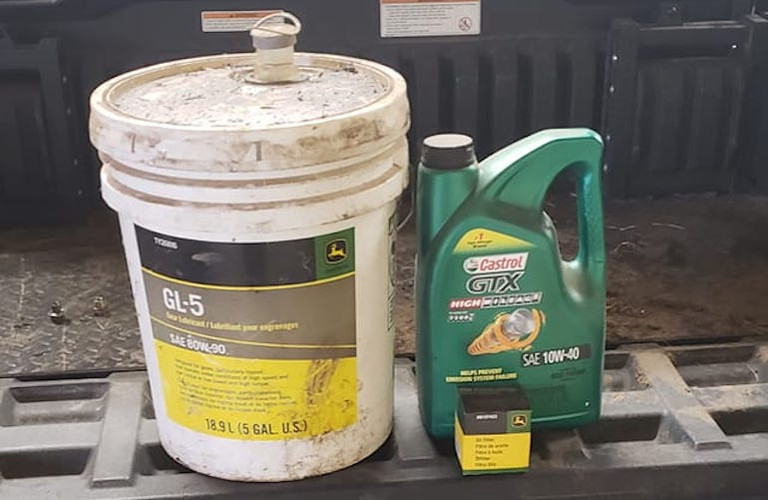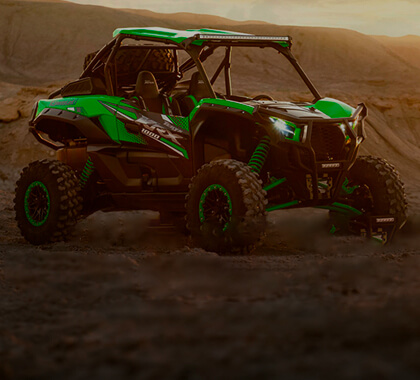What You Should Know About Lubricants, Fluids, Greases, And Oils For The Kawasaki Mule
Dec 15, 2021
Lubrication is a crucial aspect of any machine with moving parts. Any time components rub together, the resulting friction will create heat. And to control this heat, lubricants like engine oil, grease, transmission fluid, and differential fluid are key. Fail to replace these lubricants and you’ll exacerbate the everyday wear that occurs within your rig. Issues will also arise if you use the wrong kind of Kawasaki Mule oils, fluids, and lubricants. But where exactly on the Kawasaki Mule needs lubrication, and what are the best lubricants to use on each area? The answers to these questions are as follows. So here is what you should know about lubricating your Kawasaki Mule with the right gearbox fluids, engine oils, and greases!
Kawasaki Mule Oil Type, Oil Change, And Oil Capacity

The owner’s manual suggests running Kawasaki’s 10W-40 performance 4-stroke UTV / ATV engine oil in the Kawasaki Mule, but you can also run brands like Lucas' Synthetic Blend and Amsoil. Rotella T-6 Synthetic oils also meet the API and special JASO ratings for Kawasaki Mule oil, and some riders claim that Rotella T-6 5W-40 runs a lot smoother than the suggested oil weight and viscosity.
In addition to using the right Kawasaki Mule engine oil, you must also take care to pour in the right quantity of engine oil. As per the owner’s manual, 1.9 quarts is advised for an oil change. But because oil expands around 5-7% when hot, this can give you false readings when you check the oil after running the vehicle. The oil levels in Kawasaki Mule engines are designed to be checked when the engine is cold and after all the oil has drained back into the oil pan. As such, you should always add a little less oil or fluid than the manual calls for, then recheck and add more as needed to bring the level up to read correctly on the dipstick. After all, there’s a reason why vehicles come with dipsticks, and that reason is to prevent initial and habitual overfilling!

In some instances, oil can remain in the dipstick tube and give false readings on the stick, so look closely and ensure that the mark on the dipstick is straight and equal on both sides. If you do add too much oil to your Kawasaki Mule, drain some out, as an overfilled crankcase will cause windage and excess oil vapor, which will in turn gum up the carburetor and cause carbon to build up on the oil rings.
The Cherry engine inside many Kawasaki Mule editions is the same engine that’s in the John Deere Gator 825i, so using the same oil for both machines is fine. It should be noted, however, that there are two categories of engine oil, one for gasoline engines, and one for diesel engines. You’ll notice on any bottle of oil either an S or a C. The S is for spark ignition (gasoline engines), while the C is for compression ignition (diesel engines). Following either the S or the C on the bottle of oil, you’ll see another letter that indicates the recency of the oil technology. The higher the letter indicates a more-recent oil technology, and the more-recent oils are backward compatible. So an oil with the specification SN can also be used in vehicles that request API SM, SL, SJ, and so on back to SA.
Another thing that’s good to know when doing business with off-road dealerships is that it’s illegal to tie warranty coverage to whichever brand of parts or lubricants you use. Manufactures that do so must provide the parts or lubricants free of charge, and they can’t deny warranty coverage without showing that the aftermarket part or lubricant in question actually caused the failure.
Kawasaki Mule Transmission Fluid And Rear Differential Fluid

The owner’s manual is a tad confusing with regards to Kawasaki Mule transmission fluid. It specifies the use of GL-5, 80W oil when riding in temperatures under 40 degrees Fahrenheit, and 90W oil when riding at temperatures above 40 degrees Fahrenheit. This, however, makes little sense for riders who live outside the equatorial plane, where temperatures are hotter than 40 in the summer, and colder than 40 in the winter. Who is going to change their gear oil based on the season? Our guess is hardly anyone. What the manual fails to mention, however, is that 75W-80, 80W-90, and multi-viscosity GL-5 grade gear oils are all fine to use. Synthetic 75W-90 oils are particularly good choices because they act like two different oils, working well in both hot and cold climates.
The Pro Series Mule calls for GL-5 Hypoid gear oil, but if you use limited slip oil, you won’t be hurting anything. And unlike the Teryx, the Mule doesn’t require wet brake oil, just a good synthetic 80W-90 for easy shifting and proper gear lubrication!
As far as the gearbox fluid change process goes, the Kawasaki Mule has fill and drain holes in the differentials, and you simply empty the old fluid – making sure to check the color and consistency of the oil as well as watch out for metal debris – and pour the new fluid into the fill holes until they start to overflow. When changing your fluids, though, make sure that you’re parked on level ground to ensure proper fill levels!
Kawasaki Mule Grease

There are many Kawasaki Mule grease points and grease fitting that need to be periodically re-packed. Wheel bearings, for example, are notorious for going bad due to neglect, and components like a-arm bushings, steering rods, and propeller shafts also require ample amounts of grease to function properly.
Standard pump-style grease guns will work in most cases, but you can also get 20v greaser tools like the ones by Dewalt. With regards to re-greasing your Kawasaki Mule a-arms, you might find that some don’t take grease. If this happens, you can either change the grease zerks entirely, or you can try whacking the dry joints with a plastic hammer / hitting the pin or bolt that goes through the joint to free up the zerk.
When greasing the zerk fittings in your Kawasaki Mule, there are a few different grease brands that will work. Many riders choose to use Mobil 1 Synthetic Red Chassis / Wheel Bearing grease, giving their suspension zerks a lick of grease after wet rides to push out any water that might have gotten inside. The Mobil 1 grease is also good in cold-weather conditions, as it doesn’t dry up, freeze, or crust over!
Closing Remarks On Lubricating The Kawasaki Mule
Instead of consuming and regurgitating information from manuals and forums, it is better to gain a holistic understanding of the inner workings of your machine to use common-sense logic about the requisite Kawasaki Mule fluids, oils, greases, and lubricants. Depending on the terrain type and your aggressiveness behind the wheel, you might be fine if you deviate slightly from the suggested oil change, fluid change, and grease change intervals outlined in the owner’s manual. Nevertheless, even if you do end up dumping good oil by conducting an oil change earlier than you have to, or wasting a bit of grease by packing your zerks after every ride, it might be worth the extra cost and effort when considering the alternatives. While you might be able to calculate your UTVs oil life using an algorithm based on RPM, temp, and drive time, you’ll generally find that the resulting oil change interval calculations are similar to what the manual specifies. And as far as Kawasaki Mule oils go, there’s are several brands that work! So get out there and ride hard, but don’t forsake your rig by ensuring that it’s properly lubricated at all times!


